![Ventilation in older houses]()
Ventilation in Period Properties and Older Houses
Period properties and especially Victorian houses were designed to be heated by coal fires and use air circulation to ventilate and move heat around the house.
Open fires need a circulation of air to maintain the fire and to move the heat around. Fires also need ventilation in a room to maintain healthy oxygen levels.
Victorian houses had several design features that helped with ventilation:
- Large bay windows with facing windows that opened and encouraged cross ventilation
- Sash windows that could be opened at the top and bottom for extra ventilation
- Air bricks to draw air directly from the outside to the inside
- Chimneys that draw the air upwards from the fire creating pressure to draw air from windows and air vents
- Transom windows over the front door that open and draw the warm air from the fire up the stairs
- Transom windows at the back door that create cross ventilation through the house in summer
The natural design of a Victorian house follows the same principle as Passive Stack Ventilation (see below).
Apart from the design, older houses also have more gaps than modern builds so they naturally ventilate through draughts.
The problem with Victorian houses today is that they do not use coal fires and are being retro-insulated to try and retain heat and to meet EPC rating standards. Trying to heat an old house like this is very expensive and the insulation blocks the natural ventilation of the house. Moisture is trapped and the property is prone to condensation, dampness and an unhealthy atmosphere.
It's a difficult balance to achieve energy efficiency with healthy ventilation in a house not designed for that purpose.
Ventilation in Energy Efficient Homes
Why is ventilation important for energy efficient houses?
As insulation increases in a building, it becomes more airtight and ventilation is reduced. Without an exchange of air, pollutants start to condense, oxygen reduces and the overall quality of air rapidly declines to an unhealthy level.
The more energy efficient a house is, the more it needs the introduction of ventilation.
Building Regulations Approved Document Part F has been updated to ensure that houses have adequate ventilation.
What Is Passivhaus?
Passivhaus is a standard for low-energy building design and construction. The main aim of Passivhaus is to reduce the energy consumption of buildings to a minimum, specifically for heating and cooling.
Passivhaus buildings have high levels of insulation, airtightness and efficient use of passive solar gain, which helps to reduce the need for heating and cooling systems. Passivhaus buildings are also required to use mechanical ventilation systems with heat recovery, which help to ensure healthy indoor air quality.
Passivhaus buildings can be up to 90% more energy-efficient compared to traditionally built homes and designed to maintain a consistent and comfortable indoor temperature, with minimal fluctuations, and to ensure good air quality through effective ventilation. This results in a healthy and comfortable living environment, free from the harmful effects of dampness, condensation, and mould.
What Are the Different Types of Ventilation for a House?
As mentioned above, a ventilation strategy uses a combination of mechanical and natural ventilation systems. It starts to get a bit more complicated when we then factor in that Building Regulations refer to three types or approaches to ventilation that all have different applications. And these can be either mechanical or natural.
| Purge | Extract | Whole Building |
|---|
| Natural | Window opening | None | Passive stack |
| Mechanical | Extraction fan | Extraction fan or hood | MEV or MVHR |
| Application | To quickly remove heat or fumes | To quickly remove excess moisture and smell at the source | To maintain the quality of the air |
| Where | All rooms | Bathrooms & Kitchens | Whole house |
Purge
Purge ventilation is the ability to quickly remove any odours or buildup of fumes in a living space. Particularly toxic fumes from cleaning, DIY, smoking or cooking. Purge ventilation is also required by Building Regulations for the ability to cool and room and remove a build-up of excess heat.
The volume of air contained in a room must be completely replaced four times in one hour.
To meet Building Regulations, windows are required to have an opening angle of at least 15 degrees and be at least a tenth of the floor area of the room. Windows that can open more than 30 degrees can be a twentieth of the room floor area.
All habitable rooms must be able to purge ventilate through either a window, door or a mechanical extraction system.
Extract
Extract ventilation is used to quickly remove any excess moisture or cooking smells before they spread to other areas of the house.
Especially critical in bathrooms and for cooking to avoid a build-up of condensation.
Extraction can only be achieved using mechanical ventilation on either an intermittent or a continual basis.
For a bathroom or utility room, the extraction rate must be 15 litres per second. For a kitchen, the extraction rate must be 30 litres per second.
Kitchen extraction cooker hoods that only filter air and don't extract externally must be 60 litres per second.
Rooms that require extract ventilation include:
- Kitchens
- Utility rooms
- Bathrooms
- Toilets
Whole Dwelling
Purge and extract are both on-demand ventilation methods to be used as and when needed. Aside from ensuring that excess moisture and fumes are cleared, a house also needs a constant flow of background ventilation to remain healthy.
Older houses will generally fall into less airtight dwellings and modern builds should be built to certain airtight standards. Passivhaus is designed on the basis of being as airtight and insulated as possible to minimise the need for heating.
If a house has an air permeability higher than below it is considered 'less airtight':
- A design air permeability higher than 5m3/(h·m2) at 50Pa.
- An as-built air permeability higher than 3m3 /(h·m2) at 50Pa.
For less airtight houses, they have the option of natural background ventilation and can use a combination of trickle vents on windows and passive stack ventilation.
For airtight houses, a continuous mechanical supply is required using a system such as continuous mechanical extract ventilation (MEV) or Mechanical Ventilation with Heat Recovery (MVHR).
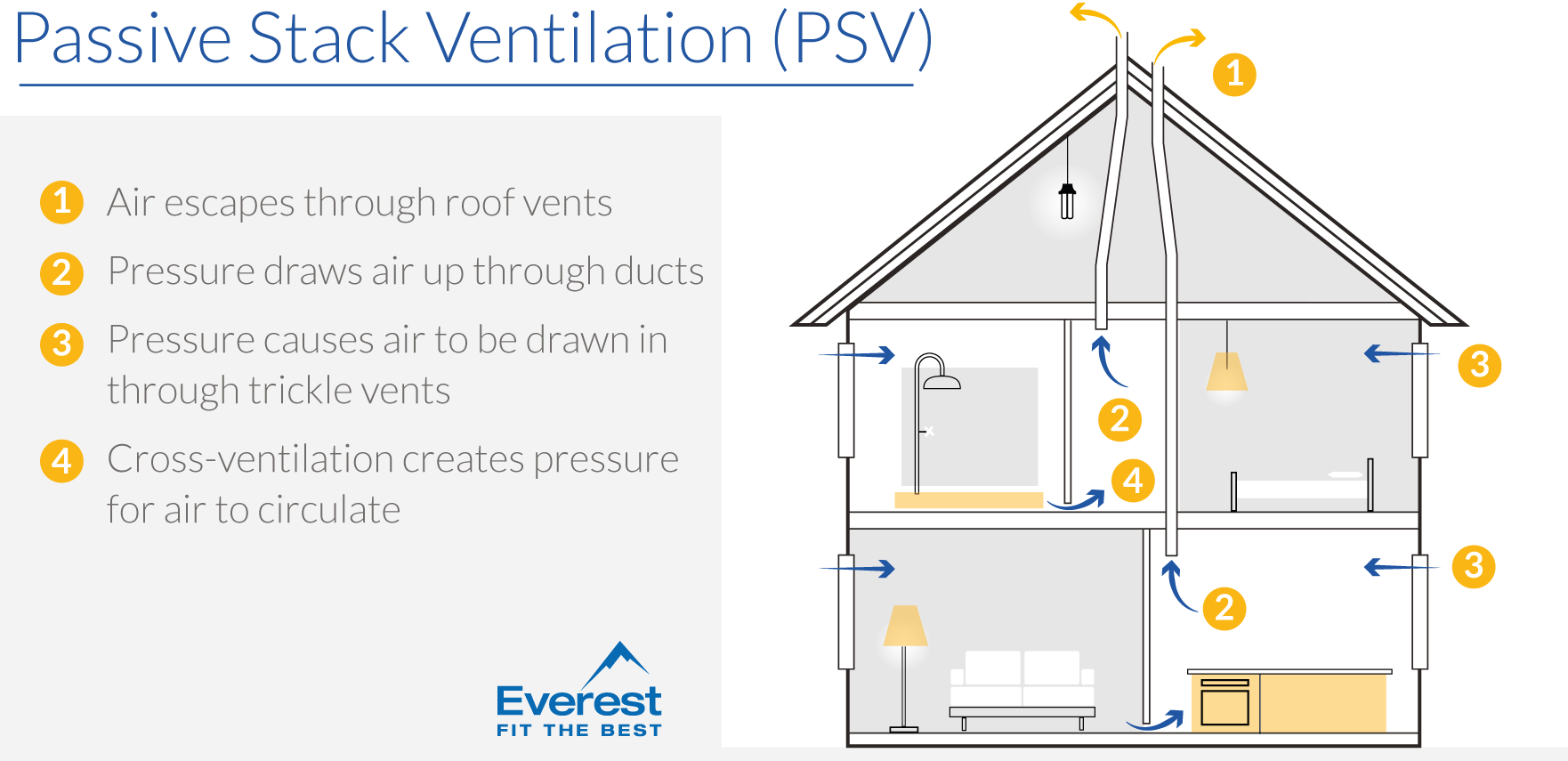
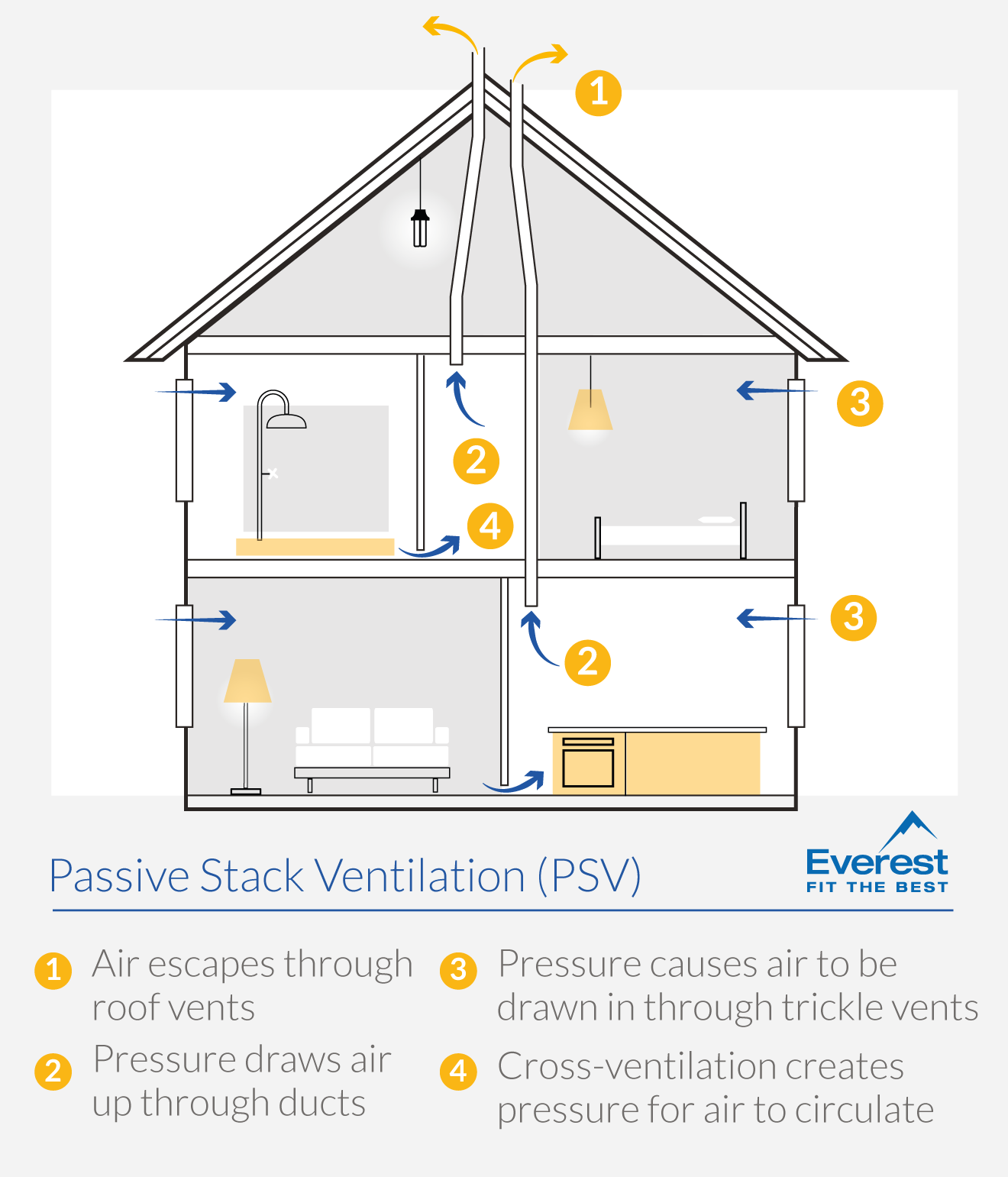
Passive Stack Ventilation (PSV)
Passive stack ventilation works on the same principles as how older houses were ventilated. By using natural air flow manipulated by natural pressure.
For example, old sash windows could open a gap at the top, which allows warm air to escape from the room. By also opening a gap at the bottom of the window, the pressure caused by air being sucked out of the top means that cool air can be sucked in through the bottom (based on the principle of warm air rising). Old chimneys also worked, in the same way, to allow the heat from the fire to move up through the walls of the house creating pressure and this would suck cool air into the room through air vents.
Imagine the same principle, but a skylight or vent at the top of a house which allows heat to escape and in turn the pressure created allows cool air to be drawn in through vents on the ground floor at a lower level.
Wind moving across a roof vent creates pressure that sucks air up and out of the vent. In turn, this creates airflow upwards through the house.
Using cross ventilation also creates pressure to draw air through rooms so all parts of a house are ventilated.
Passive Stack is designed to use natural air pressure through a system of vents and ducts for natural extraction and air flow ventilation.
However, it can be draughty and requires manual intervention unless you install an intelligent system that opens and closes the vents automatically.
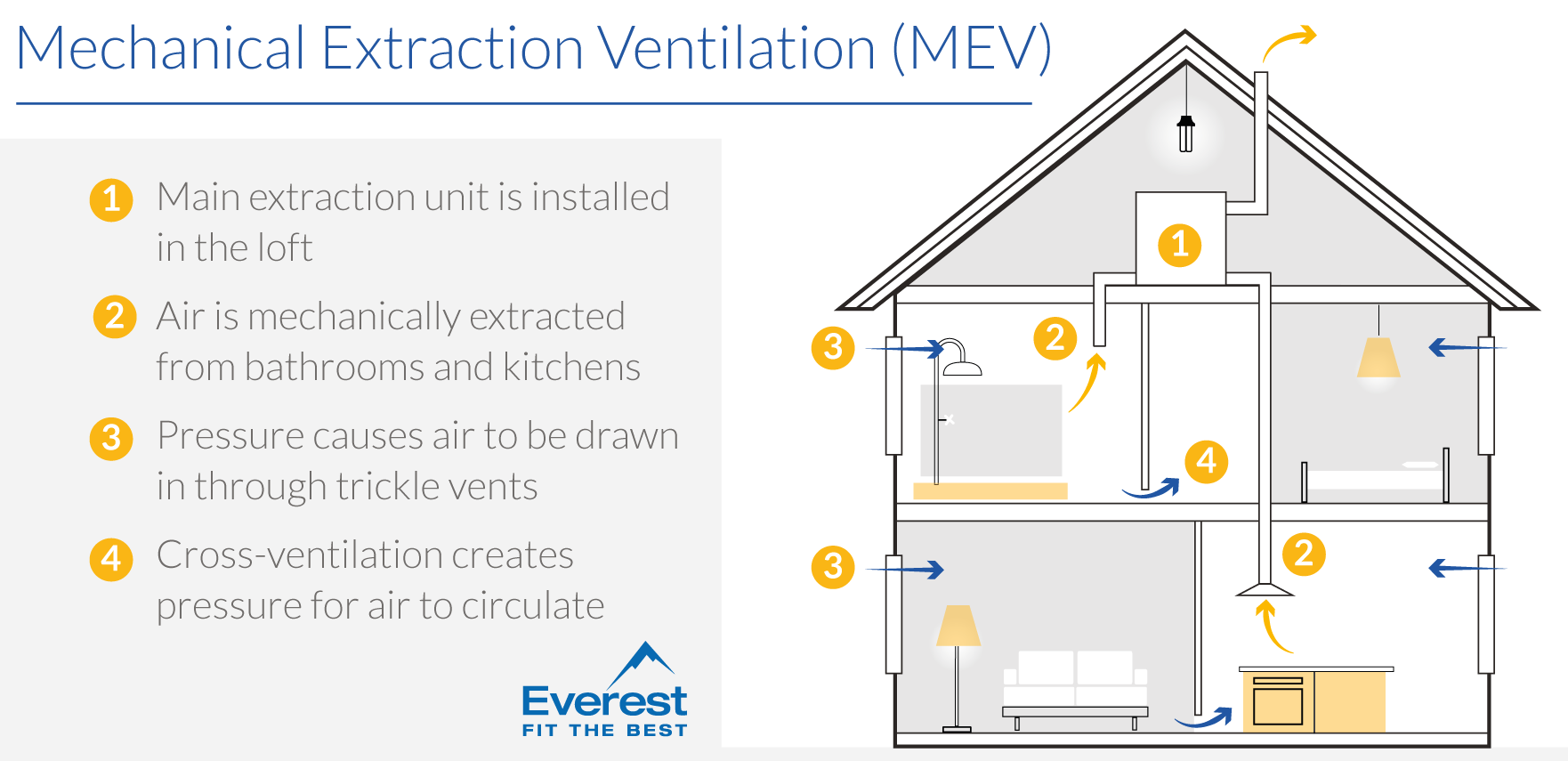
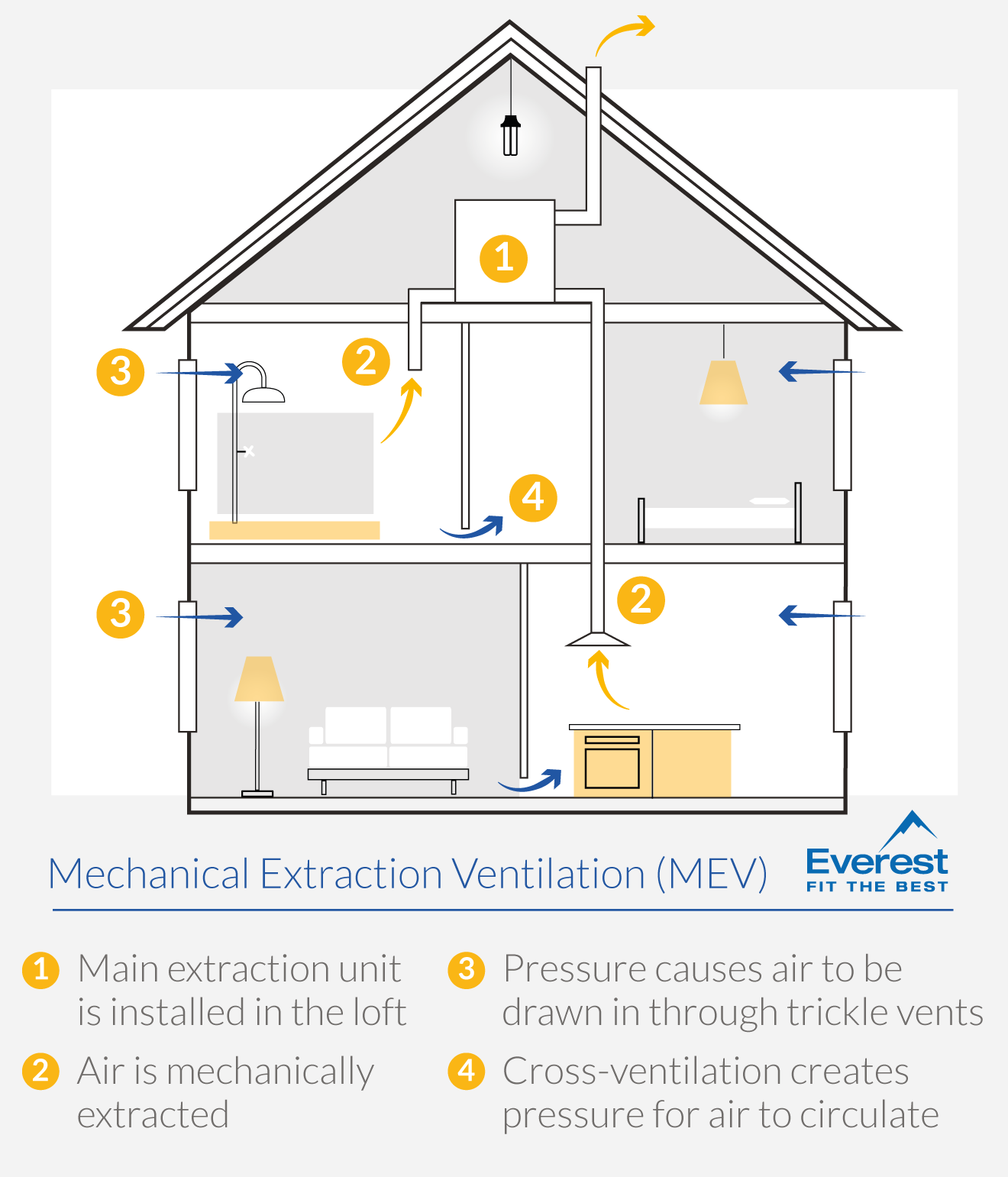
Mechanical Extract Ventilation (MEV)
The mechanical extract ventilator (MEV) is a multi-room integrated system that has a central extraction unit usually fitted in the loft space. It has ducts to the bathrooms, wet rooms and kitchens that continuously extract moisture from the air.
As a progression of the natural passive stack system, the MEV system uses mechanical ventilation. The extraction ducts create pressure that draws in air through external background vents and trickle vents in the windows. This generates an air flow and cross ventilation through the rooms to ensure whole house ventilation.
The system also has a boost facility for accelerated extraction on demand to remove excessive moisture and fumes.
A mechanical extract ventilator can usually only be fitted to new build properties as the ducting is integrated into the fabric of the building. Retrofitting can be difficult and expensive.
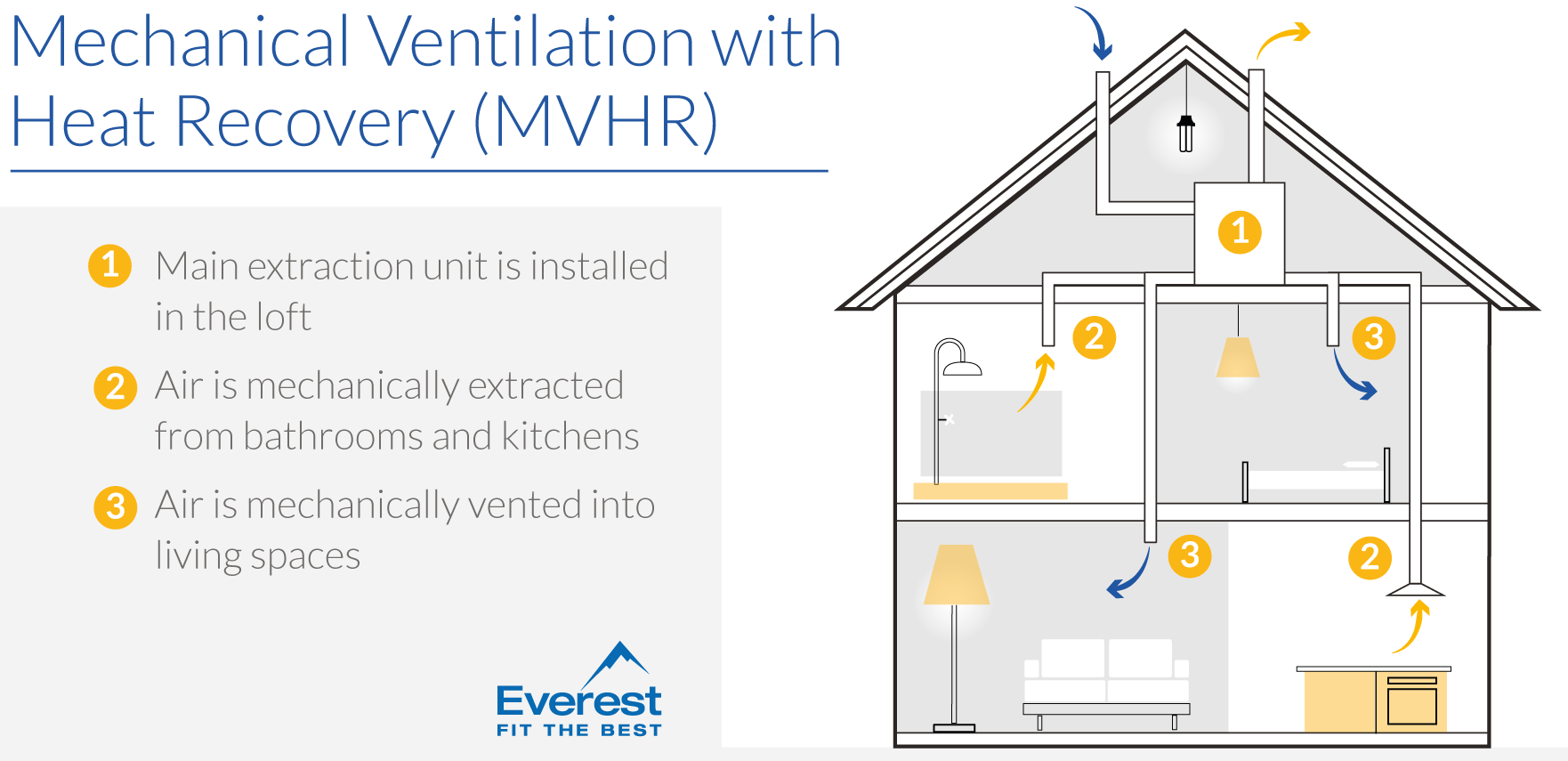
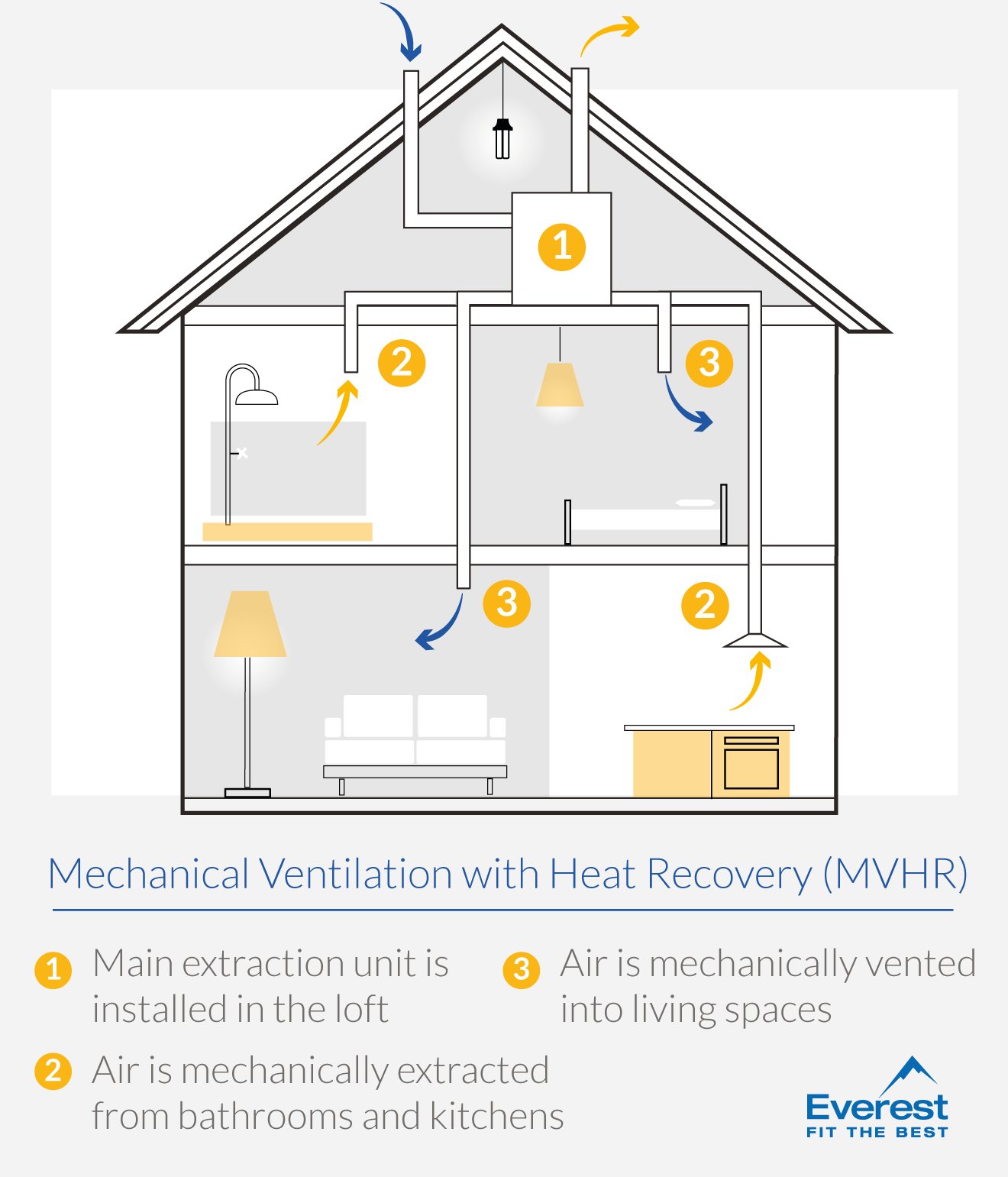
Mechanical Ventilation with Heat Recovery (MVHR)
Mechanical ventilation with heat recovery (MVHR) is a multi-room system that uses centralised extraction the same as an MEV system. The difference to an MEV is that the MVHR extracts and supplies the air from the same system.
Ducts to bathrooms and kitchens extract the humid air and then pass it through a heat exchanger to warm it before recirculating it into other living spaces.
MVHR systems are highly efficient and economical when used in airtight houses and are a central part of the design standards of Passivhaus.